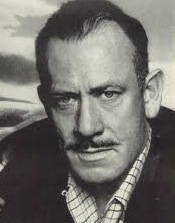05.01

This week (May 1-7) in literary history – Joseph Heller was born (May 1, 1923); Manuscript of Conversations at Midnight by Edna St. Vincent Millay were destroyed in hotel fire (May 2, 1936); Western author Andy Adams was born (May 3, 1859); Lord Byron swam across the Hellespont Strait in Turkey (May 3, 1810); Norman Mailer published first novel The Naked and the Dead (May 4, 1948); John Keats published first poem in The Examiner (May 5, 1816); John Steinbeck won the Pulitzer prize for The Grapes of Wrath (May 6, 1940); Robert Browning was born (May 7, 1812); author Michael Thomas Barry was born (May 7, 1963): Thornton Wilder won the Pulitzer Prize for The Bridge of San Luis Rey (May 7, 1928)
Highlighted Story of the Week –
On May 6, 1940, John Steinbeck was awarded the Pulitzer Prize for his novel The Grapes of Wrath. The book traces the fictional Joad family of Oklahoma as they lose their family farm and move to California in search of a better life. They encounter only more difficulties and a downward slide into poverty. The novel combines simple, plain-spoken language and compelling plot with rich description. One of Steinbeck’s most effective works of social commentary, the novel also won the National Book Award.
Like The Grapes of Wrath, much of Steinbeck’s work dealt with his native state of California. He was born and raised in the Salinas Valley, where his father was a county official and his mother a former schoolteacher. Steinbeck was a good student and president of his senior class in high school. He attended Stanford University intermittently between 1920 and 1925, then moved to New York City, where he worked as a manual laborer and a journalist while writing stories and novels. His first two novels were not successful.
He married and moved to Pacific Grove in 1930, where his father gave him a house and a small income while he continued to write. His third novel, Tortilla Flat (1935), was a critical and financial success, as were his subsequent novels In Dubious Battle (1935) and Of Mice and Men (1937), both of which offered social commentaries on injustices of various types. His work after World War II, including Cannery Row and The Pearl, continued to offer social criticism but became more sentimental. Steinbeck tried his hand at movie scripts in the 1940s, writing such successful films as Forgotten Village (1941) and Viva Zapata (1952). He also took up the serious study of marine biology and published a nonfiction book, The Sea of Cortez, in 1941. His book Travels with Charlie describes his trek across the U.S. in a camper truck with his poodle, Charlie, and his encounters with a fragmented America. Steinbeck won the Nobel Prize in 1962 and died in New York in 1968. His remains were cremated and buried alongside his parents and maternal grandparents at the Salinas Cemetery.
Check back every Friday for a new installment of “This Week in Literary History.”
Michael Thomas Barry is the author of six nonfiction books that include the awards winning Literary Legends of the British Isles and America’s Literary Legends.











